Abstract
Invasive alien plants (IAPs) present a significant threat to ecosystems and agricultural production, necessitating rigorous monitoring and detection for effective management and control. To realize accurate and rapid detection of invasive alien plants in the wild, we proposed a rapid detection approach grounded in an advanced YOLOv9, referred to as YOLO-IAPs, which incorporated several key enhancements to YOLOv9, including replacing the down-sampling layers in the model’s backbone with a DynamicConv module, integrating a Triplet Attention mechanism into the model, and replacing the original CIoU with the MPDloU. These targeted enhancements collectively resulted in a substantial improvement in the model’s accuracy and robustness. Extensive training and testing on a self-constructed dataset demonstrated that the proposed model achieved an accuracy of 90.7%, with the corresponding recall, mAP50, and mAP50:95 measured at 84.3%, 91.2%, and 65.1%, and a detection speed of 72 FPS. Compared to the baseline, the proposed model showed increases of 0.2% in precision, 3.5% in recall, and 1.0% in mAP50. Additionally, YOLO-IAPs outperformed other state-of-the-art object detection models, including YOLOv5, YOLOv6, YOLOv7, YOLOv8, YOLOv10 series, Faster R-CNN, SSD, CenterNet, and RetinaNet, demonstrating superior detection capabilities. Ablation studies further confirmed that the proposed model was effective, contributing to the overall improvement in performance, which underscored its pre-eminence in the domain of invasive alien plant detection and offered a marked improvement in detection accuracy over traditional methodologies. The findings suggest that the proposed approach has the potential to advance the technological landscape of invasive plant monitoring.
1. Introduction
The accelerated process of globalization and the expansion of human activities have increasingly exacerbated the issue of invasive plant species (IAPs) [1]. Invasive alien plants disrupt native biodiversity and ecological balance, inflicting damage on agriculture and ecosystems, and leading to substantial economic losses [2,3,4,5], which are also regarded as one of the greatest global threats to biodiversity and ecosystems [6,7,8]. Given the considerable challenges associated with eradicating these species once they have established in the wild, prevention is considered the most effective and desirable method for control [9,10,11]. However, despite preventive measures, the risk of IAPs remains persistent. Consequently, early detection is critical for preventing the establishment, spread, and adverse impacts of these species [12]. Rapid detection and swift response are essential to slow down or prevent the expansion of IAPs, mitigate damage to local ecosystems, and avert economic losses [13,14].
Historically, the monitoring and management of invasive alien plants have heavily relied on manual inspections and records [5,15,16]. These methods, however, are labor-intensive, resource-demanding, and inefficient [12,17,18], with potential inconsistencies and errors in records occurring due to the varying experience and expertise of inspectors [19], especially in complex field environments.
Image recognition methods have played a pivotal role in monitoring and managing these species over the years. Early approaches relied heavily on classical techniques such as thresholding, edge detection, and region-growing algorithms. These methods were simple and computationally efficient but often struggled with complex and variable environmental conditions, such as uneven lighting or overlapping objects. Subsequently, unsupervised machine learning approaches like K-means clustering [20] and support vector machines (SVMs) [21] gained popularity, offering improved performance in semi-structured data scenarios. However, these methods required extensive feature engineering and lacked scalability for high-dimensional data.
In recent years, remote sensing technologies have been increasingly employed in the monitoring of invasive alien plants [22,23,24], offering broader spatial coverage and essential data for habitat mapping, population monitoring, and analysis of invasive species [25]. As a result, remote sensing offers a time-efficient and cost-effective alternative [6,26,27,28], with successful applications in the monitoring of several IAPs, including Spartina alterniflora [8,29], Acacia longifolia [30], and Ailanthus altissima [31]. However, hyperspectral image data, primarily acquired via satellites [6], entail high costs for high-resolution spectral data, which are often limited to smaller geographical areas [32]. Several researchers have also explored the integration of deep learning models for identifying invasive alien plants from drone imagery [33,34,35,36,37,38]. Hao et al. [39] utilized high-resolution unmanned aerial vehicle (UAV) images combined with deep learning methods to monitor the spread of Pistia stratiotes, achieving impressive accuracy in aquatic plant monitoring. While UAVs offer a promising solution for monitoring IAPs in localized areas with high spatial and temporal resolution [22,40], their operation can be constrained by factors such as weather conditions and airspace restrictions.
In recent years, deep learning has revolutionized image recognition with its ability to learn hierarchical features directly from raw data, outperforming classical and traditional machine learning methods in various tasks. Popular object detection architectures, including Faster R-CNN [41], RetinaNet [42], Centernet [43], and YOLO (You Only Look Once), have become central to applications in agriculture, ecology, and beyond. Faster R-CNN introduced region proposal networks (RPNs) for precise object localization, making it highly accurate but computationally intensive. RetinaNet balanced precision and speed through focal loss, addressing challenges in detecting small or rare objects. YOLO, however, emerged as a real-time object detection framework, offering high efficiency by combining detection and classification into a single network pass. Its evolution has consistently pushed the boundaries of accuracy and speed, making it a suitable choice for agricultural and ecological object detection [44,45,46,47,48]. For instance, Chen et al. [49] introduced TSP-YOLO, an efficient, fast, and real-time method for counting cabbage seedlings using an improved YOLOv8n model, achieving a mAP50-95 of 90.3% in accurately tracking seedlings in the field. Li et al. [50] tackled the challenges of detecting cotton leaf diseases and pests under natural conditions with a novel model called LSKNet-YOLOv8s, providing valuable technical resources for the identification and control of cotton pests and diseases. Sekharamantry et al. [51] refined the YOLOv5 architecture to enable the real-time detection of apples against complex backgrounds, achieving an overall accuracy of 0.97 for precision, 0.99 for recall, and 0.98 for the F1 score.
In this context, we propose YOLO-IAPs, an enhanced version of the YOLOv9 model tailored for the detection of IAPs. This model is specifically optimized to provide high efficiency and accuracy in monitoring invasive species, thereby offering vital technological support for ecological conservation and biodiversity protection. Moreover, the methodologies presented could serve as a reference for future applications in other environmental monitoring contexts and smart agriculture. The key improvements to YOLOv9 are as follows:
DynamicConv Module Replacement: The original down-sampling module in the YOLOv9 backbone is replaced with the DynamicConv module, which significantly enhances the model’s ability to adapt to varying input features with minimal additional computational cost (FLOPs).
Incorporation of Triplet Attention: A Triplet Attention module is introduced prior to the detection head, enabling the model to capture more comprehensive information from the input data through multi-level attention mechanisms, thereby improving detection accuracy.
MPDloU Loss Function: To address issues such as false positives and missed detections commonly encountered in IAP monitoring, the traditional CIoU Loss Function is replaced with MPDloU Loss Function. This adjustment provides a better balance between detection precision and speed, ultimately enhancing the model’s overall performance and reliability.
2. Materials and Methods
2.1. Image Acquisition
In this study, images of five common invasive alien plant species in China were collected using a range of handheld imaging devices, including smartphones Realmeneo2 RMX3370 (Realme, Shenzhen, China) and iPhone 14 (Apple Inc., Cupertino, CA, USA) and a GoPro action camera (GoPro, Inc, San Mateo, CA, USA). The species targeted for this study were Ambrosia artemisiifolia L. (AaL), Lantana camara L. (LcL), Sesbania cannabina Pers. (ScP), Solanum rostratum Dunal (SrD), and Xanthium strumarium L. (XsL), most of which have become naturalized and are now widespread as roadside and farmland allochthonous invasive weed species. The images were captured at three different monitoring sites, with the GPS coordinates (40.4° N, 113.9° E), (43.5° N, 83.4° E), and (22.6° N, 114.1° E), during the period from June to October 2023, between 10:00 a.m. and 4:00 p.m. The images were taken under natural lighting conditions using various shooting angles and heights to ensure diversity and variability, thereby enhancing the model’s robustness. Additionally, to further enrich the dataset, we searched for and downloaded additional relevant IAP images from online sources using specific keywords (Figure 1).
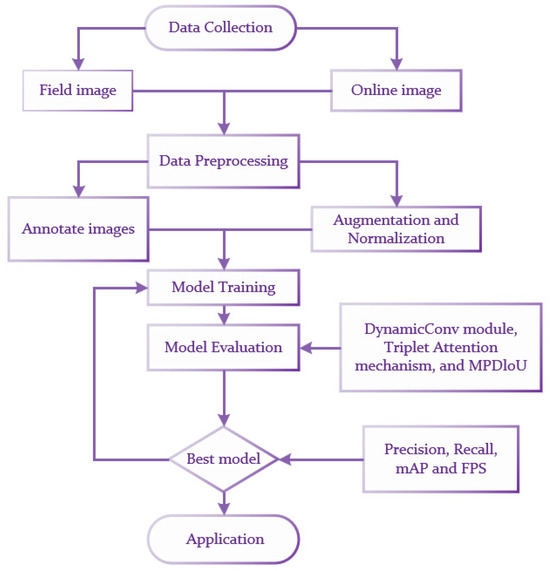
Figure 1.
The workflow from data collection and preprocessing to model training, evaluation, and application.
A total of 2657 valid images were collected, including 395 images of AaL, 664 of LcL, 538 of ScP, 762 of SrD, and 298 of XsL. The dataset included images with different angles, heights, lighting variations, object deformations, occlusions, and complex backgrounds, as well as various growth stages of the selected species (e.g., both flowering and non-flowering stages of LcL and SrD). Figure 2 presents partial examples of the five IAP species included in the study.
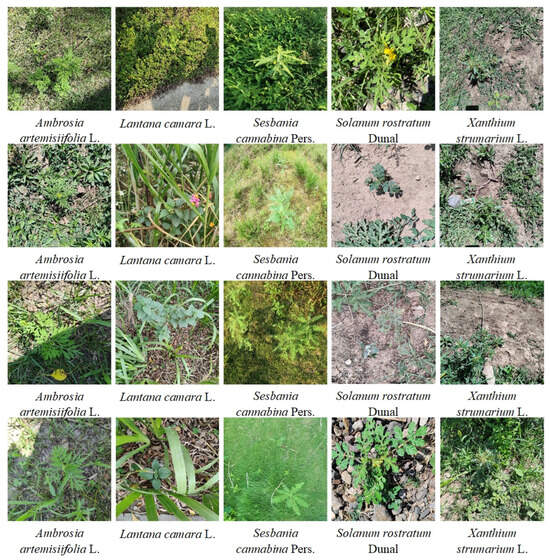
Figure 2.
Partial effective images of five IAPs.
2.2. Data Annotation
In this study, all images of IAPs were annotated using LabelImg, with the annotations saved in the format required by YOLO, specifically as .txt. During the annotation process, we consulted domain experts to ensure the accuracy and reliability of the labeling. Specifically, we collaborated with Fanghao Wan and Bo Liu, who have extensive experience in the field of invasive plant research. Finally, each plant was marked within the smallest possible bounding box, minimizing the inclusion of backgrounds to enhance localization accuracy [52]. The label distribution statistics for the training set are illustrated in Figure 3. Among the annotated samples, SrD had the highest number of annotated instances, while XsL had the fewest. This discrepancy is primarily due to the former species often appearing with multiple instances in a single image, whereas the latter typically appears as a single instance per image. Additionally, the bounding boxes exhibited consistent scale variations, which aligned with the natural growth characteristics of IAPs in real environments. The majority of the bounding box center coordinates (x, y) were concentrated predominantly near the center of the images, with aspect ratios close to 1.
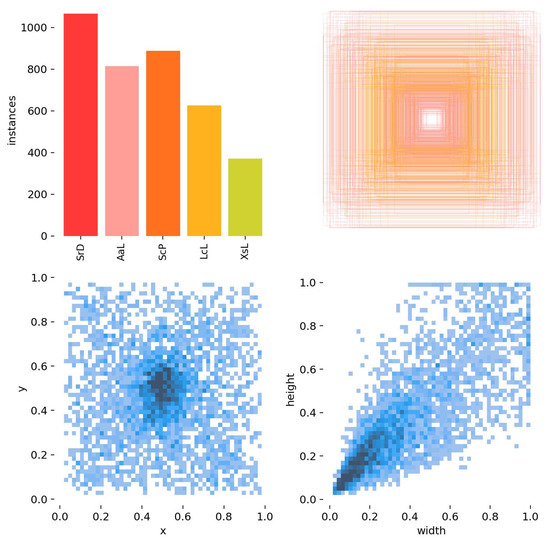
Figure 3.
The label-related distribution of bounding boxes for the dataset. The blue lines and boxes represent the relative position of the center point of the target in the image, the darker the color indicates that there are more center points of the target in the area.
2.3. Image Detection Model
2.3.1. YOLO Series Model
In the domain of image object detection, the YOLO series of algorithms has remained a top choice among researchers, known for its exceptional detection accuracy and speed. Since its initial introduction by Joseph Redmon and colleagues at CVPR 2016 [53], the YOLO family has developed from YOLOv1 to YOLOv10, with YOLOv5 [54] and YOLOv8 [55] gaining significant attention in recent years for their practical applications. YOLOv5 brought notable improvements through a lightweight network architecture, innovative training strategies, and enhanced data augmentation techniques, boosting the model’s overall performance. Building on these advancements, YOLOv8 further refined the architecture of YOLOv5 by incorporating design advantages from earlier versions while preserving the streamlined and user-friendly nature of YOLOv5. In addition, YOLOv8’s deeper and more complex network structure, combined with improved training techniques, resulted in substantial gains in both detection accuracy and speed.
The latest iterations, YOLOv9 [56] and YOLOv10 [57], released this year, have set new benchmarks in performance and efficiency, surpassing their predecessors. YOLOv10, in particular, introduced a design strategy driven by a balance between efficiency and accuracy, optimizing the trade-off between performance and computational cost. Although YOLOv10 eliminates the need for post-processing non-maximum suppression (NMS), which significantly reduces latency, it does not surpass YOLOv9 in terms of detection accuracy, and its generalization capability in practical scenarios is somewhat less robust than that of YOLOv9.
YOLOv9, on the other hand, introduced two groundbreaking techniques, Programmable Gradient Information (PGI) and the General Efficient Layer Aggregation Network (GELAN), which effectively addressed information bottlenecks, thereby significantly enhancing both accuracy and efficiency in object detection. Results from validation tests on challenging datasets like MS COCO demonstrate that YOLOv9 has established a new performance benchmark in the field of object detection, excelling across metrics of efficiency, speed, and accuracy. As a result, YOLOv9 has become one of the most advanced solutions available for object detection tasks (Figure 4).
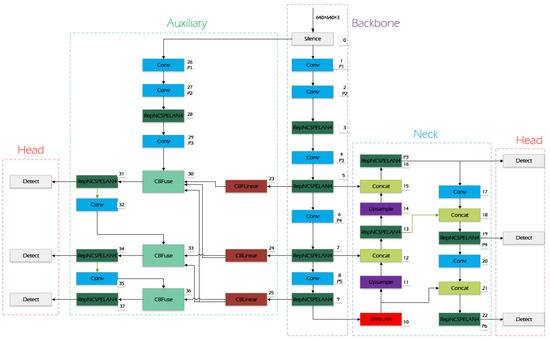
Figure 4.
The original network structure of YOLOv9.
2.3.2. Proposed Network Architecture for YOLO-IAPs
The network architecture of YOLO-IAPs is depicted in Figure 5. First, the down-sampling module in the backbone of YOLOv9 was replaced with a DynamicConv module [58]. This modification increases the network’s capacity without significantly adding extra FLOPs. Unlike traditional static convolution, dynamic convolution generates a set of convolutional kernels that adapt to the input data on the fly. These kernels are dynamically adjusted during each forward pass based on the input or specific conditions, allowing the network to better handle diverse input features. This dynamic selection process is intended to enhance the model’s ability to represent features and improve generalization.
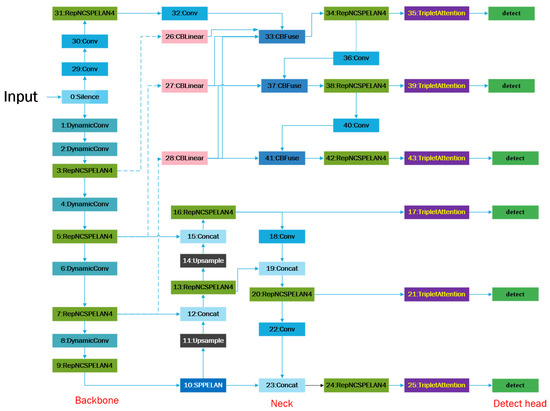
Figure 5.
The network structure of YOLO-IAPs.
Second, a Triplet Attention module [59] was incorporated before each detection head in YOLOv9. Triplet Attention is a lightweight, efficient attention mechanism that calculates attention weights by capturing cross-dimensional interactions through a three-branch structure. For each input tensor, Triplet Attention establishes cross-dimensional dependencies via rotational transformations and encodes cross-channel and spatial information with minimal computational overhead. By introducing attention mechanisms at multiple levels, this module enhances the model’s ability to capture critical information from the input data, thereby improving overall detection performance.
Lastly, to address potential issues with false positives and missed detections in the detection of IAPs, the CIoU Loss Function in YOLOv9 was replaced with MPDloU Loss [60], aiming to better balance the trade-off between precise detection and rapid recognition. As the CIoU Loss Function primarily focuses on aspect ratio differences, which may not fully capture the true discrepancies between predicted and ground truth boxes, this hinders similarity optimization and slows down convergence, ultimately reducing detection accuracy [61]. In contrast, MPDloU Loss provides a more comprehensive and accurate evaluation of the predicted bounding boxes, effectively reducing false positives and missed detections, thereby enhancing the overall performance of the model.
Dynamic Conv Module
Dynamic convolution extends traditional convolution by dynamically selecting or combining different convolutional kernels, referred to as “experts”, for each input sample. Instead of using a fixed kernel for all inputs, dynamic convolution adapts the network’s parameters based on the specific characteristics of the input data, which is achieved by having multiple kernels available, with the most appropriate kernel chosen dynamically for each input. The selection process is governed by a learned function, such as a multilayer perceptron (MLP) paired with a softmax function, which dynamically generates weights that determine the contribution of each kernel.
The computation process can be described as follows: Given an input feature map X and a set of convolutional kernels , , …, , each associated with an expert, the network dynamically computes a set of coefficients for each input. These coefficients determine the contribution of each kernel. The output is then produced by taking a weighted sum of the convolutions performed by these kernels:
where GAP is the global average pooling operation, is a multilayer perceptron, ∗ represents the convolution operation, and is derived from a small auxiliary network, such as an MLP, which processes globally average pooled features from the input.
By sharing and dynamically combining convolutional kernels, dynamic convolution significantly increases the model’s parameter capacity while incurring minimal additional computational cost, which allows more complex network architectures to be deployed in resource-constrained environments, like mobile devices, without substantially increasing computational demands. Moreover, dynamic convolution enhances the model’s ability to represent features and can be seamlessly integrated into existing architectures as a substitute for standard convolutional layers.
Triplet Attention Mechanism
Triplet Attention is designed to enhance feature representation by introducing attention mechanisms at multiple levels, enabling the model to capture more comprehensive information from the input data. While traditional attention mechanisms typically compute attention weights within the same feature level, Triplet Attention operates across three distinct levels, calculating attention weights at each level to form a more holistic understanding of the input, hence the term “triplet”.
The Triplet Attention module is composed of three branches, each responsible for capturing interactions between the spatial dimensions (height or width) and the channel dimension. Each branch starts with channel pooling, followed by a 7 × 7 convolution, Z pooling, another 7 × 7 convolution, and is then passed through batch normalization and a Sigmoid activation function. A Permute operation is applied to adjust the dimensions in each branch. Finally, the outputs from the three branches are aggregated via average pooling, resulting in the final set of attention weights. The structure of the Triplet Attention module is illustrated as follows:
Each module in the Triplet Attention mechanism is specifically designed to process feature maps of the size , where represents the number of channels, the height, and the width. These modules compute attention weights through various methods to enhance the network’s focus on critical features, thereby improving performance in a range of visual tasks. In Figure 6, the symbols indicate matrix multiplication and broadcast element-wise addition.
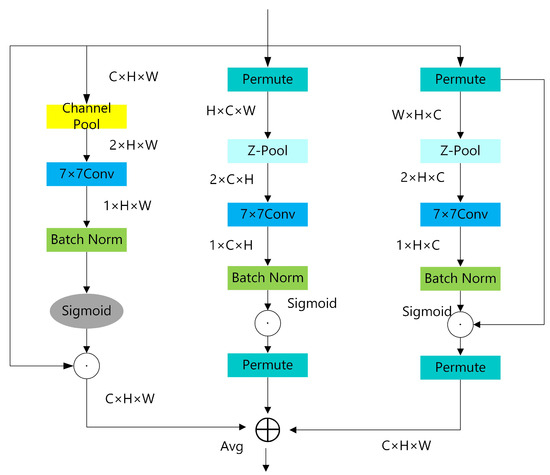
Figure 6.
The network structure of the Triplet Attention module.
Generally, this structure leverages different rotation and permutation operations to integrate information across different dimensions, allowing the network to capture the intrinsic features of the data more effectively, which is computationally efficient and can be easily integrated into existing network architectures, enhancing the network’s ability to understand and process complex data structures. Even with the addition of three new attention branches, Triplet Attention maintains a relatively low computational complexity, making it suitable for use in resource-constrained environments.
Loss Function Improvement
When the predicted box and the ground truth box share the same aspect ratio but differ significantly in width and height, many existing bounding box regression loss functions struggle to optimize effectively. Moreover, traditional loss functions can yield identical values for different prediction results, leading to slower convergence and reduced accuracy in bounding box regression. To overcome these issues and enhance both the convergence speed and accuracy of our deep learning model, MPDloU was implemented as the bounding box loss function in the proposed model.
MPDloU is a novel metric for bounding box similarity that minimizes the distance between the top-left and bottom-right corners of the predicted and ground truth boxes. This metric provides a straightforward and efficient solution for improving bounding box regression. MPDloU encompasses all the critical factors considered in existing loss functions—such as overlap or non-overlap regions, center point distance, and width–height deviation—while also simplifying the overall computation process. MPDloU is outlined in Equations (3)–(5):
where , , , and denote the coordinates of the top-left and bottom-right corners from the predicted bounding box, respectively. Likewise, , , , and represent the coordinates of the top-left and bottom-right corners from the ground truth bounding box. The IoU measures the overlap between the predicted and ground truth boxes, while and h refer to the width and height of the input image, respectively. refers to the loss function.
MPDIoU streamlines the process of comparing the similarity between two bounding boxes, making it applicable to both overlapping and non-overlapping cases. By offering a more precise error measurement, the MPDIoU Loss Function facilitates faster convergence during model training, thereby enhancing overall training efficiency (Figure 7).
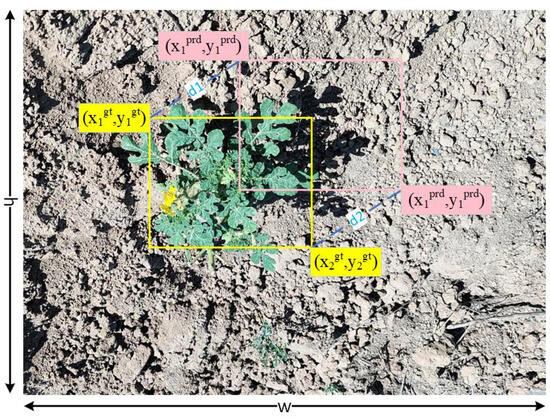
Figure 7.
Calculation of loss parameters for MPDIoU.
2.4. Experimental Settings
In this study, the 2657 IAP images were split into training, testing, and validation sets in an 8:1:1 ratio. The experiments were conducted on a system running Windows Server 2022 Standard (64-bit), equipped with a 13th Gen Intel(R) Core(TM)i9-13900 CPU @ 2.00 GHz, and 64 GB of RAM. The software environment included Python 3.10 and CUDA 12.1. The network l training was performed using the PyTorch 2.2.2 framework. The experimental setup and specific parameter configurations are detailed in the table below (Table 1).

Table 1.
Experimental test platform.
To mitigate the effects of sample imbalance, we applied extensive data augmentation techniques, such as rotation, flipping, cropping, brightness adjustments, and noise addition. Moreover, mini-batch sampling was balanced to ensure that each batch contained a representative mix of samples from all species. This approach prevented the model from overfitting to the dominant classes during training iterations (Table 2).

Table 2.
Training parameters of the IAP detection model.
2.5. Evaluation Metrics
In this paper, precision (P), recall (R), average precision (AP), frames per second (FPS), and mean average precision (mAP) were selected as the evaluation metrics for assessing model performance. Precision is defined as the proportion of true positive cases among the predicted positive cases, while recall indicates the percentage of true positive cases correctly identified as positive by the model. FPS serves as an indicator of the model’s detection speed, while mAP provides a comprehensive assessment of the model’s overall detection performance across multiple object classes, making it a critical metric for evaluating object detectors. The formulas for these metrics are provided in Equations (6)–(9).
where TP represents true positives, indicating the number of IAPs correctly predicted by the model; FP refers to false positives, representing the number of non-IAPs incorrectly predicted as IAPs by the model; FN denotes false negatives, where the model fails to correctly identify IAPs; is the smoothed precision–recall curve; AP represents the average precision across different recall levels and can be interpreted as the area under the precision–recall curve; N is the total number of classes; and represents the average precision for the th class.
3. Result and Discussion
3.1. Training Results of the YOLO-IAPs Network
The loss function in this study consists of three components: box_loss, obj_loss, and cls_loss. As depicted in Figure 8a, during the initial 25 epochs of training, both the training loss and validation loss exhibit a steep decline. From epochs 25 to 100, the rate of decline in these losses slows, and from epochs 100 to 190, the loss values stabilize with minimal fluctuations. In the final 10 epochs, the training loss decreases further due to the disabling of mosaic augmentation, while the validation loss remains relatively stable. At this stage, the training process is considered complete, and the model’s best-performing weights are selected as the final result for subsequent analysis.
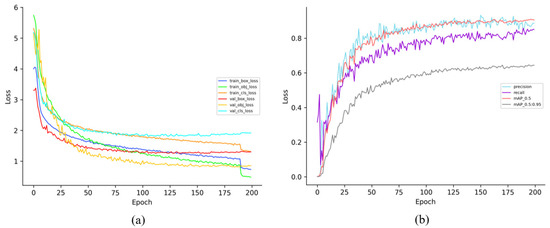
Figure 8.
The training process of the proposed model. (a) The training loss and validation loss change curves for the model training process. (b) The precision, recall, and mAP change curves for the model training process.
Figure 8b shows the changes in precision, recall, and AP values throughout the training process. As shown in the figure, these metrics gradually improve with increasing epochs and eventually stabilize. Notably, the recall curve exhibits significant fluctuations during the early stages of training, while the precision and mAP0.5 curves are nearly identical. After 200 epochs, the model’s precision, recall, mAP0.5, and mAP0.5:0.9 fluctuate around 0.90, 0.84, 0.91, and 0.65, respectively, indicating that the model has achieved the desired training outcome.
3.2. Results from Different Detection Models
3.2.1. Comparisons with Other YOLO Versions
To assess the effectiveness of the improved model, we specifically compared YOLO-IAPs with various versions of YOLO to evaluate its performance. The dataset and classification used for these experiments were consistent across all models, with randomly initialized weights. The overall performance results for the different detection models are presented in Table 3.

Table 3.
Comparisons with other YOLO series models.
As shown in Table 3, the best-performing models in terms of precision, recall, mAP0.5, mAP0.5:0.9, and FPS were YOLOv10n (92.7%), YOLOv8x (88.1%), YOLO-IAPs (91.2%), YOLOv5x (67.4%), and YOLOv5n (286), respectively. Conversely, the YOLOv6 and YOLOv7 models exhibited slightly weaker detection performance on the IAP dataset compared to other versions. Notably, the precision and mAP0.5 for YOLOv7-tiny and YOLOv7x were below 80%, with mAP0.5:0.9 falling short of 50%, and their precision, recall, and mAP0.5 values hovering around 76%. The YOLO-IAPs achieved the highest F1 score (87.4%) among the evaluated models, demonstrating a well-balanced trade-off between precision and recall. This highlights the effectiveness of the proposed enhancements, such as DynamicConv and Triplet Attention, in maintaining high accuracy while reducing false negatives.
The remaining YOLOv5, YOLOv8, YOLOv9, and YOLOv10 versions, however, demonstrated significantly better overall performance, with precision and mAP0.5 scores consistently exceeding 90%. For the YOLOv5 and YOLOv8 series, we observed that as the model size and depth increased from the “n” to “x” versions, the precision and mAP0.5 initially improved but then declined, indicating that larger and deeper models do not always yield better outcomes. Compared to previous versions, YOLOv9 and YOLOv10 showed higher precision, with only slight differences in mAP between them, while YOLOv10 outpaced YOLOv9 in inference speed, being more than twice as fast.
Although YOLOv10n delivered higher precision, YOLOv9 demonstrated superior mAP performance. Interestingly, despite being newer than YOLOv5, the YOLOv6 and YOLOv7 models did not perform as well on the IAP dataset, suggesting that newer versions do not necessarily guarantee better results. While the proposed YOLO-IAPs model did not achieve the highest precision, it surpassed other models in mAP0.5—a key metric for evaluating multi-class object detection—indicating stronger overall detection capabilities. In summary, YOLO-IAPs provides a more balanced overall precision with a higher mAP score, reflecting superior comprehensive performance on the custom IAPs dataset. Additionally, with a detection speed of 72 FPS, YOLO-IAPs shows significant potential for deployment on mobile platforms for real-time automatic monitoring and management of IAPs.
Figure 9 reveals that while YOLOv8 and YOLOv10 achieve faster convergence compared to YOLO-IAPs and YOLOv9, their final mAP values are noticeably lower, with only slight differences in precision. The improved model, in comparison to YOLOv9, not only delivers better overall performance metrics but also converges more rapidly, highlighting the superiority of the proposed model.
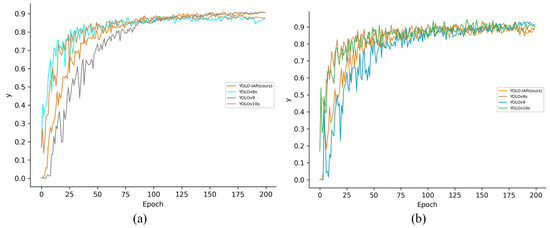
Figure 9.
Comparisons with other several YOLO versions. (a) The mAP:0.5 change curves of YOLOv8s, YOLOv9, YOLO-IAPs, and YOLOv10s. (b) The precision change curves of YOLOv8s, YOLOv9, YOLO-IAPs, and YOLOv10s.
3.2.2. Comparative Analysis Between YOLO-IAPs and Other Non-YOLO Networks
To validate the effectiveness of the improved YOLOv9, we compared the YOLO-IAPs with Faster R-CNN, CenterNet, RetinaNet, and SSD in terms of object class-wise mAP (0.5). While SSD exhibited relatively consistent precision across classes, its overall performance was unsatisfactory, with accuracy falling below 50%. Faster R-CNN showed reasonable performance in detecting AaL and XsL, but struggled with other IAPs. In comparison, RetinaNet generally outperformed Faster R-CNN, except in the detection of AaL, while the lowest precision was observed for SRD and the highest for XsL. Centernet’s dot plot takes on a concave parabolic shape.
The YOLO-IAPS model, however, achieved significantly higher accuracy across all classes compared to the other state-of-the-art (SOTA) models, with precision scores exceeding 90%, except for LcL, which had only a precision of 86.5%—likely attributed to its more complex background compared to other species—yet still within an acceptable range. Overall, the proposed model demonstrated superior detection capabilities across all invasive alien plants, outperforming the other non-yolo models. The results are presented in Table 4 and Figure 10.

Table 4.
Object class-wise mAP (0.5) across different SOTA models.
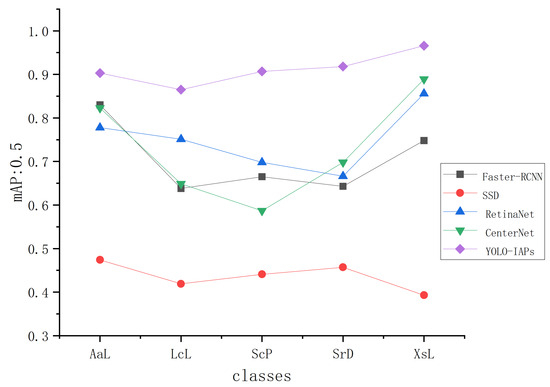
Figure 10.
Comparison between object class-wise mAP (0.5) across different models.
3.3. Ablation Experiment
To further assess the impact of each module introduced into the network architecture, we conducted ablation studies using YOLOv9 as the baseline. Seven different improvement strategies were tested on the dataset, and the performance of the baseline YOLOv9 was also compared with that of the proposed model. The results of these experiments are shown in Table 5.

Table 5.
Ablation experiment results of the proposed model.
The table reveals that each individual improvement strategy resulted in an increase in recall and mAP, though there were some trade-offs in detection precision. Notably, the model with the Triplet Attention module performed the best, achieving a 0.6% increase in mAP0.5 with almost no additional parameters or GFLOPs compared to the original model. On the other hand, incorporating the DynamicConv module significantly increased the number of parameters, but also resulted in a 17.2% reduction in GFLOPs.
However, when combining any two improvement strategies, a trade-off was observed between precision and mAP. Although precision generally improved, mAP experienced a slight decline, with the combination of Triplet Attention and MPDIoU outperforming the other pairings.
To strike a balance between detection precision and mAP, we integrated all three improvement strategies, which resulted in the best overall performance, with improvements in mAP0.5, precision, and recall of 0.2%, 3.5%, and 1.0%, respectively, while also reducing the model’s GFLOPs. The improvement in GFLOPs is largely attributed to the introduction of the DynamicConv module, which not only lowered computational demands but also enhanced the model’s feature representation and generalization capabilities. Moreover, the Triplet Attention mechanism, with its multi-level feature representation, allowed the model to capture input data more comprehensively, while MPDIoU provided a balanced approach between convergence speed and accuracy.
On the whole, these results indicate that DynamicConv, Triplet Attention, and MPDIoU are compatible and, when combined, significantly enhance the model’s overall performance. Additionally, we observed that the detection speeds of YOLOv9 and its seven improved variants did not differ significantly, all meeting the requirements for real-time detection. The results of these experiments are shown in Figure 11.
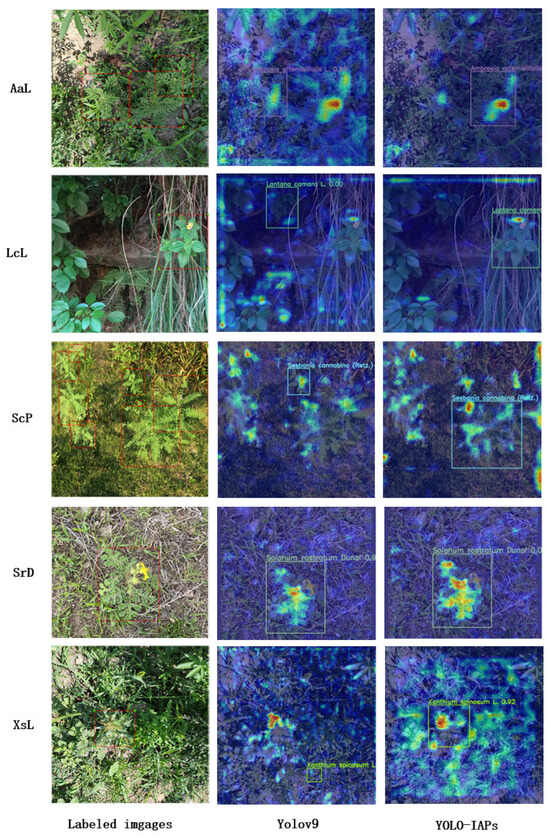
Figure 11.
Partial test set identification results of YOLOv9 and YOLO-IAPs.
We also used Grad-CAM to intuitively illustrate the feature extraction results of YOLOv9 and YOLO-IAPs. Figure 11 presents examples of predictions made by YOLOv9 and YOLO-IAPs on images of five IAPs species. While both models produced visually satisfactory predictions, a comparison reveals that YOLOv9 struggled with false positives and missed detections, particularly for LcL and ScP, which led to a decrease in precision. In contrast, the YOLO-IAPs model effectively minimized these issues, demonstrating its enhanced effectiveness in multi-class IAP detection.
The challenges faced by YOLOv9 can be attributed to the complex and similar background colors in LcL images, which interfered with the model’s accuracy, and the overlapping and occlusion in ScP images, which caused the model to detect only one target, complicating accurate identification. These findings indicate that YOLO-IAPs not only meets real-time processing requirements but also offers higher detection precision, making it a more suitable choice for IAP detection.
3.4. Discussion
Invasive alien plants (IAPs) present a significant challenge for identification and control due to their diverse species, some of which exhibit inter-species homogeneity or intra-species heterogeneity [62]. The proposed YOLO-IAPs model, while primarily tested on Ambrosia artemisiifolia L. (AaL), Lantana camara L. (LcL), Sesbania cannabina Pers. (ScP), Solanum rostratum Dunal (SrD), and Xanthium strumarium L. (XsL), is designed to be adaptable to the detection of other IAP species as well. Our experiments on a custom-built dataset revealed that, although the YOLO series models performed well overall, YOLOv5 outperformed both YOLOv6 and YOLOv7, and YOLOv9 proved more effective than YOLOv10, which suggests that newer models do not always guarantee better performance and that outcomes can vary depending on the dataset and context. Compared to Faster R-CNN, RetinaNet, CenterNet, and SSD, the proposed model delivered superior results for the five invasive alien plant species, with average precision exceeding 90%, further highlighting the advantages of the YOLO series over other classical object detection algorithms.
The addition of the Triplet Attention mechanism introduces an overhead due to its channel-wise and spatial attention computations. Specifically, the mechanism processes input feature maps along three distinct dimensions—horizontal, vertical, and channel-wise—to generate attention weights. These additional computations require a lightweight auxiliary network, but the overall complexity is proportional to the feature map dimensions and scales linearly with the number of channels. Importantly, the auxiliary network used in Triplet Attention is lightweight by design, ensuring that the increase in FLOPs is minimal compared to the overall cost of the YOLO backbone and detection head.
Ablation studies confirmed that DynamicConv, Triplet Attention, and MPDIoU work well together, collectively enhancing the model’s detection capabilities and making it more suitable for IAP detection. Compared to existing monitoring methods, YOLO-IAPs has shown tremendous potential for practical application, offering higher detection accuracy and efficiency while significantly reducing monitoring costs. Unlike drone- or satellite-based remote sensing, YOLO-IAPs can achieve higher precision and accuracy without being affected by terrain or weather conditions.
Furthermore, the proposed model offers significant advancements in invasive alien plant detection compared to traditional methods, but also provides valuable insights and references for IAP identification, contributing to the development of monitoring technologies for invasive species. Although YOLO-IAPs reduces false positives and missed detections, as shown in Figure 11, these issues cannot be entirely eliminated. The complex backgrounds and high levels of occlusion or overlap in some IAPs, such as LcL and ScP, continue to pose challenges.
4. Conclusions
YOLO-IAPs, an improved version of YOLOv9, specifically designed for invasive alien plant detection, provides an efficient and accurate solution for monitoring invasive species in field environments. This paper details the improvements and the technical implementation of YOLO-IAPs, supported by experimental evidence of its effectiveness in detecting invasive alien plants. The results demonstrate that YOLO-IAPs achieved an accuracy of 90.7% on the invasive plant dataset, with the highest mAP of 91.2%, recall of 84.3%, mAP50:95 of 65.1%, and detection speed of 72 FPS. Compared to the baseline YOLOv9 model, the proposed model showed improvements in precision, recall, and mAP50 of 0.2%, 3.5%, and 1.0%, respectively. Additionally, YOLO-IAPs outperformed other state-of-the-art models, including YOLOv5, YOLOv6, YOLOv7, YOLOv8, YOLOv10, Faster R-CNN, SSD, CenterNet, and RetinaNet, underscoring its effectiveness in enhancing accuracy.
Future research will focus on further optimizing the model to enhance its adaptability to more complex environments and exploring its potential applications in other ecological monitoring areas. We aim for our work to advance the development of invasive plant monitoring technologies, offering critical support for ecological protection and biodiversity conservation, while also serving as a valuable reference for future applications in environmental monitoring and precision agriculture.
Author Contributions
Y.H.: Writing—original draft, Methodology, Formal analysis. H.H.: Writing—review and editing, Validation, Software, Methodology, Formal analysis, Data curation. F.Q.: Supervision, Resources. Y.C.: Supervision, Resources. J.Z.: Resources. B.L.: Writing—review and editing, Resources. Z.L.: Writing—review and editing, Supervision. C.L.: Writing—review and editing, Resources. F.W.: Resources, Investigation. W.Q.: Funding acquisition, Supervision, Resources. X.Q.: Funding acquisition, Project administration, Resources, Writing—review and editing. All authors have read and agreed to the published version of the manuscript.
Funding
This research was funded by the National Key Research and Development Program of China (2022YFC2601500 and 2022YFC2601504), the National Natural Science Foundation of China (32272633), the Guangxi Natural Science Foundation of China (2021JJA130221), the Shenzhen Science and Technology Program (KCXFZ20230731093259009), and the Agricultural Science and Technology Innovation Program.
Institutional Review Board Statement
Not applicable.
Data Availability Statement
The original contributions presented in this study are included in the article. Further inquiries can be directed to the corresponding author.
Conflicts of Interest
The authors declare no conflict of interest.
References
- Wang, Y.-J.; Müller-Schärer, H.; van Kleunen, M.; Cai, A.-M.; Zhang, P.; Yan, R.; Dong, B.-C.; Yu, F.-H. Invasive alien plants benefit more from clonal integration in heterogeneous environments than natives. New Phytol. 2017, 216, 1072–1078. [Google Scholar] [CrossRef] [PubMed]
- Knapp, L.S.P.; Coyle, D.R.; Dey, D.C.; Fraser, J.S.; Hutchinson, T.; Jenkins, M.A.; Kern, C.C.; Knapp, B.O.; Maddox, D.; Pinchot, C.; et al. Invasive plant management in eastern North American Forests: A systematic review. For. Ecol. Manag. 2023, 550, 121517. [Google Scholar] [CrossRef]
- Sun, J.; Khattak, W.A.; Abbas, A.; Nawaz, M.; Hameed, R.; Javed, Q.; Bo, Y.; Khan, K.A.; Du, D. Ecological adaptability of invasive weeds under environmental pollutants: A review. Environ. Exp. Bot. 2023, 215, 105492. [Google Scholar] [CrossRef]
- Lake, T.A.; Briscoe Runquist, R.D.; Moeller, D.A. Deep learning detects invasive plant species across complex landscapes using Worldview-2 and Planetscope satellite imagery. Remote Sens. Ecol. Conserv. 2022, 8, 875–889. [Google Scholar] [CrossRef]
- Diagne, C.; Leroy, B.; Vaissiere, A.-C.; Gozlan, R.E.; Roiz, D.; Jaric, I.; Salles, J.-M.; Bradshaw, C.J.A.; Courchamp, F. High and rising economic costs of biological invasions worldwide. Nature 2022, 608, E35. [Google Scholar] [CrossRef]
- Qian, W.; Huang, Y.; Liu, Q.; Fan, W.; Sun, Z.; Dong, H.; Wan, F.; Qiao, X. UAV and a deep convolutional neural network for monitoring invasive alien plants in the wild. Comput. Electron. Agric. 2020, 174, 105519. [Google Scholar] [CrossRef]
- Khanna, S.; Santos, M.J.; Boyer, J.D.; Shapiro, K.D.; Bellvert, J.; Ustin, S.L. Water primrose invasion changes successional pathways in an estuarine ecosystem. Ecosphere 2018, 9, e02418. [Google Scholar] [CrossRef]
- Liu, M.; Mao, D.; Wang, Z.; Li, L.; Man, W.; Jia, M.; Ren, C.; Zhang, Y. Rapid invasion of Spartina alterniflora in the coastal zone of mainland china: New observations from landsat OLI images. Remote Sens. 2018, 10, 1933. [Google Scholar] [CrossRef]
- Singh Yadav, S.P.; Mehata, D.K.; Pokhrel, S.; Ghimire, N.P.; Gyawali, P.; Katel, S.; Timilsina, U. Invasive alien plant species (Banmara): Investigating its invasive potential, ecological consequences on biodiversity, and management strategies. J. Agric. Food Res. 2024, 15, 101031. [Google Scholar] [CrossRef]
- Takaya, K.; Sasaki, Y.; Ise, T. Automatic detection of alien plant species in action camera images using the chopped picture method and the potential of citizen science. Breed. Sci. 2022, 72, 96–106. [Google Scholar] [CrossRef]
- Leung, B.; Lodge, D.M.; Finnoff, D.; Shogren, J.F.; Lewis, M.A.; Lamberti, G. An ounce of prevention or a pound of cure: Bioeconomic risk analysis of invasive species. Proc. R. Soc. B-Biol. Sci. 2002, 269, 2407–2413. [Google Scholar] [CrossRef] [PubMed]
- Wang, Q.; Cheng, M.; Huang, S.; Cai, Z.; Zhang, J.; Yuan, H. A deep learning approach incorporating YOLO v5 and attention mechanisms for field real-time detection of the invasive weed Solanum rostratum Dunal seedlings. Comput. Electron. Agric. 2022, 199, 107194. [Google Scholar] [CrossRef]
- Hao, Q.; Ma, J.-S. Invasive alien plants in China: An update. Plant Divers. 2023, 45, 117–121. [Google Scholar] [CrossRef] [PubMed]
- Reaser, J.K.; Burgiel, S.W.; Kirkey, J.; Brantley, K.A.; Veatch, S.D.; Burgos-Rodriguez, J. The early detection of and rapid response (EDRR) to invasive species: A conceptual framework and federal capacities assessment. Biol. Invasions 2020, 22, 1–19. [Google Scholar] [CrossRef]
- De Sa, N.C.; Carvalho, S.; Castro, P.; Marchante, E.; Marchante, H. Using Landsat Time Series to Understand How Management and Disturbances Influence the Expansion of an Invasive Tree. IEEE J. Sel. Top. Appl. Earth Obs. Remote Sens. 2017, 10, 3243–3253. [Google Scholar] [CrossRef]
- Mukherjee, A.; Velankar, A.D.; Kumara, H.N. Invasive prosopis juliflora replacing the native floral community over three decades: A case study of a world heritage Site, Keoladeo National Park, India. Biodivers. Conserv. 2017, 26, 2839–2856. [Google Scholar] [CrossRef]
- Li, Y.; Guo, Z.; Shuang, F.; Zhang, M.; Li, X. Key technologies of machine vision for weeding robots: A review and benchmark. Comput. Electron. Agric. 2022, 196, 106880. [Google Scholar] [CrossRef]
- Razfar, N.; True, J.; Bassiouny, R.; Venkatesh, V.; Kashef, R. Weed detection in soybean crops using custom lightweight deep learning models. J. Agric. Food Res. 2022, 8, 100308. [Google Scholar] [CrossRef]
- Ma, J.S. Alien Invasive Flora of China; Shanghai Jiaotong University Press: Shanghai, China, 2020. (In Chinese) [Google Scholar]
- Tang, J.; Wang, D.; Zhang, Z.; He, L.; Xin, J.; Xu, Y. Weed identification based on K-means feature learning combined with convolutional neural network. Comput. Electron. Agric. 2017, 135, 63–70. [Google Scholar] [CrossRef]
- Aláez, F.M.B.; Palenzuela, J.M.T.; Spyrakos, E.; Vilas, L.G. Machine Learning Methods Applied to the Prediction of Pseudo-nitzschia spp. Blooms in the Galician Rias Baixas (NW Spain). ISPRS Int. J. Geo-Inf. 2021, 10, 199. [Google Scholar] [CrossRef]
- Dyrmann, M.; Mortensen, A.K.; Linneberg, L.; Hoye, T.T.; Bjerge, K. Camera Assisted Roadside Monitoring for Invasive Alien Plant Species Using Deep Learning. Sensors 2021, 21, 6126. [Google Scholar] [CrossRef] [PubMed]
- Bradley, B.A. Remote detection of invasive plants: A review of spectral, textural and phenological approaches. Biol. Invasions 2014, 16, 1411–1425. [Google Scholar] [CrossRef]
- Huang, C.; Asner, G.P. Applications of Remote Sensing to Alien Invasive Plant Studies. Sensors 2009, 9, 4869–4889. [Google Scholar] [CrossRef] [PubMed]
- Saranya, K.R.L.; Satish, K.V.; Reddy, C.S. Remote sensing enabled essential biodiversity variables for invasive alien species management: Towards the development of spatial decision support system. Biol. Invasions 2024, 26, 943–951. [Google Scholar] [CrossRef]
- Thürkow, F.; Lorenz, C.G.; Pause, M.; Birger, J. Advanced Detection of Invasive Neophytes in Agricultural Landscapes: A Multisensory and Multiscale Remote Sensing Approach. Remote Sens. 2024, 16, 500. [Google Scholar] [CrossRef]
- Sidike, P.; Sagan, V.; Maimaitijiang, M.; Maimaitiyiming, M.; Shakoor, N.; Burken, J.; Mockler, T.; Fritschi, F.B. dPEN: Deep Progressively Expanded Network for mapping heterogeneous agricultural landscape using WorldView-3 satellite imagery. Remote Sens. Environ. 2019, 221, 756–772. [Google Scholar] [CrossRef]
- Vaz, A.S.; Alcaraz-Segura, D.; Campos, J.C.; Vicente, J.R.; Honrado, J.P. Managing plant invasions through the lens of remote sensing: A review of progress and the way forward. Sci. Total Environ. 2018, 642, 1328–1339. [Google Scholar] [CrossRef]
- Qiu, Y.; Lu, J. Dynamic simulation of Spartina alterniflora based on CA-Markov model—A case study of Xiangshan bay of Ningbo City, China. Aquat. Invasions 2018, 13, 299–309. [Google Scholar] [CrossRef]
- Grosse-Stoltenberg, A.; Hellmann, C.; Thiele, J.; Werner, C.; Oldeland, J. Early detection of GPP-related regime shifts after plant invasion by integrating imaging spectroscopy with airborne LiDAR. Remote Sens. Environ. 2018, 209, 780–792. [Google Scholar] [CrossRef]
- Tarantino, C.; Casella, F.; Adamo, M.; Lucas, R.; Beierkuhnlein, C.; Blonda, P. Ailanthus altissima mapping from multi-temporal very high resolution satellite images. ISPRS J. Photogramm. Remote Sens. 2019, 147, 90–103. [Google Scholar] [CrossRef]
- Kganyago, M.; Odindi, J.; Adjorlolo, C.; Mhangara, P. Evaluating the capability of Landsat 8 OLI and SPOT 6 for discriminating invasive alien species in the African Savanna landscape. Int. J. Appl. Earth Obs. Geoinf. 2018, 67, 10–19. [Google Scholar] [CrossRef]
- Bakacsy, L.; Tobak, Z.; van Leeuwen, B.; Szilassi, P.; Biró, C.; Szatmári, J. Drone-Based Identification and Monitoring of Two Invasive Alien Plant Species in Open Sand Grasslands by Six RGB Vegetation Indices. Drones 2023, 7, 207. [Google Scholar] [CrossRef]
- Cruz, C.; McGuinness, K.; Perrin, P.M.; O’Connell, J.; Martin, J.R.; Connolly, J. Improving the mapping of coastal invasive species using UAV imagery and deep learning. Int. J. Remote Sens. 2023, 44, 5713–5735. [Google Scholar] [CrossRef]
- Ajayi, O.G.; Ashi, J.; Guda, B. Performance evaluation of YOLO v5 model for automatic crop and weed classification on UAV images. Smart Agric. Technol. 2023, 5, 100231. [Google Scholar] [CrossRef]
- Chen, X.; Chen, T.; Meng, H.; Zhang, Z.; Wang, D.; Sun, J.; Wang, J. An improved algorithm based on YOLOv5 for detecting Ambrosia trifida in UAV images. Front. Plant Sci. 2024, 15, 1360419. [Google Scholar] [CrossRef]
- Chaudhuri, G.; Mishra, N.B. Detection of Aquatic Invasive Plants in Wetlands of the Upper Mississippi River from UAV Imagery Using Transfer Learning. Remote Sens. 2023, 15, 734. [Google Scholar] [CrossRef]
- Costello, B.; Osunkoya, O.O.; Sandino, J.; Marinic, W.; Trotter, P.; Shi, B.; Gonzalez, F.; Dhileepan, K. Detection of parthenium weed (Parthenium hysterophorus L.) and its growth stages using artificial intelligence. Agriculture 2022, 12, 1838. [Google Scholar] [CrossRef]
- Hao, Z.; Lin, L.; Post, C.J.; Mikhailova, E.A. Monitoring the spatial-temporal distribution of invasive plant in urban water using deep learning and remote sensing technology. Ecol. Indic. 2024, 162, 112061. [Google Scholar] [CrossRef]
- Dash, J.P.; Watt, M.S.; Paul, T.S.H.; Morgenroth, J.; Hartley, R. Taking a closer look at invasive alien plant research: A review of the current state, opportunities, and future directions for UAVs. Methods Ecol. Evol. 2019, 10, 2020–2033. [Google Scholar] [CrossRef]
- Gong, X.; Zhang, S. A High-Precision Detection Method of Apple Leaf Diseases Using Improved Faster R-CNN. Agriculture 2023, 13, 240. [Google Scholar] [CrossRef]
- Peng, H.; Chen, H.; Zhang, X.; Liu, H.; Chen, K.; Xiong, J. Retinanet_G2S: A multi-scale feature fusion-based network for fruit detection of punna navel oranges in complex field environments. Precis. Agric. 2024, 25, 889–913. [Google Scholar] [CrossRef]
- Lin, Z.; Guo, W. Cotton stand counting from unmanned aerial system imagery using MobileNet and CenterNet deep learning models. Remote Sens. 2021, 13, 2822. [Google Scholar] [CrossRef]
- Tetila, E.C.; da Silveira, F.A.G.; da Costa, A.B.; Amorim, W.P.; Astolfi, G.; Pistori, H.; Barbedo, J.G.A. YOLO performance analysis for real-time detection of soybean pests. Smart Agric. Technol. 2024, 7, 100405. [Google Scholar] [CrossRef]
- Gao, G.; Shuai, C.; Wang, S.; Ding, T. Using improved YOLO V5s to recognize tomatoes in a continuous working environment. SIViP 2024, 18, 4019–4028. [Google Scholar] [CrossRef]
- Kaukab, S.; Komal; Ghodki, B.M.; Ray, H.; Kalnar, Y.B.; Narsaiah, K.; Brar, J.S. Improving real-time apple fruit detection: Multi-modal data and depth fusion with non-targeted background removal. Ecol. Inform. 2024, 82, 102691. [Google Scholar] [CrossRef]
- Li, Q.; Ma, W.; Li, H.; Zhang, X.; Zhang, R.; Zhou, W. Cotton-YOLO: Improved YOLOV7 for rapid detection of foreign fibers in seed cotton. Comput. Electron. Agric. 2024, 219, 108752. [Google Scholar] [CrossRef]
- Zhu, X.; Chen, F.; Zheng, Y.; Peng, X.; Chen, C. An efficient method for detecting Camellia oleifera fruit under complex orchard environment. Sci. Hortic. 2024, 330, 113091. [Google Scholar] [CrossRef]
- Chen, X.; Liu, T.; Han, K.; Jin, X.; Wang, J.; Kong, X.; Yu, J. TSP-yolo-based deep learning method for monitoring cabbage seedling emergence. Eur. J. Agron. 2024, 157, 127191. [Google Scholar] [CrossRef]
- Li, R.; He, Y.; Li, Y.; Qin, W.; Abbas, A.; Ji, R.; Li, S.; Wu, Y.; Sun, X.; Yang, J. Identification of cotton pest and disease based on CFNet-VoV-GCSP-LSKNet-YOLOv8s: A new era of precision agriculture. Front. Plant Sci. 2024, 15, 1348402. [Google Scholar] [CrossRef]
- Sekharamantry, P.K.; Melgani, F.; Malacarne, J. Deep Learning-Based Apple Detection with Attention Module and Improved Loss Function in YOLO. Remote Sens. 2023, 15, 1516. [Google Scholar] [CrossRef]
- Fan, X.; Sun, T.; Chai, X.; Zhou, J. YOLO-WDNet: A lightweight and accurate model for weeds detection in cotton field. Comput. Electron. Agric. 2024, 225, 109317. [Google Scholar] [CrossRef]
- Redmon, J.; Divvala, S.; Girshick, R.; Farhadi, A. You Only Look Once: Unified, Real-Time Object Detection. In Proceedings of the 2016 IEEE Conference on Computer Vision and Pattern Recognition (CVPR), Las Vegas, NV, USA, 27–30 June 2016. [Google Scholar]
- Jocher, G. YOLOv5 by Ultralytics. 2020. Available online: https://github.com/ultralytics/yolov5 (accessed on 26 September 2024).
- Jocher, G.; Chaurasia, A.; Qiu, J. YOLO by Ultralytics. 2023. Available online: https://github.com/ultralytics/ultralytics (accessed on 26 September 2024).
- Wang, C.-Y.; Yeh, I.H.; Liao, H.-Y.M. YOLOv9: Learning What You Want to Learn Using Programmable Gradient Information. arXiv 2024, arXiv:2402.13616. [Google Scholar]
- Wang, A.; Chen, H.; Liu, L.; Chen, K.; Lin, Z.; Han, J.; Ding, G. YOLOv10: Real-Time End-to-End Object Detection. arXiv 2024, arXiv:2405.14458. [Google Scholar]
- Han, K.; Wang, Y.; Guo, J.; Wu, E. ParameterNet: Parameters Are All You Need. arXiv 2024, arXiv:2306.14525. [Google Scholar]
- Misra, D.; Nalamada, T.; Arasanipalai, A.U.; Hou, Q.; IEEE. Rotate to Attend: Convolutional Triplet Attention Module. In Proceedings of the 2021 IEEE Winter Conference on Applications of Computer Vision WACV, Waikoloa, HI, USA, 3–8 January 2021. [Google Scholar]
- Ma, S.; Xu, Y. MPDIoU: A Loss for Efficient and Accurate Bounding Box Regression. arXiv 2023, arXiv:2307.07662. [Google Scholar]
- Zhan, W.; Sun, C.; Wang, M.; She, J.; Zhang, Y.; Zhang, Z.; Sun, Y. An improved YOLOv5 real-time detection method for small objects captured by UAV. Soft Comput. 2022, 26, 361–373. [Google Scholar] [CrossRef]
- Wu, H.; Liu, W.; Xian, X.; Zhao, M.; Yao, Q. A lightweight identification model for alien invasive plants based on improved mobilenet. Plant Prot. 2024, 50, 85–96. [Google Scholar] [CrossRef]
Disclaimer/Publisher’s Note: The statements, opinions and data contained in all publications are solely those of the individual author(s) and contributor(s) and not of MDPI and/or the editor(s). MDPI and/or the editor(s) disclaim responsibility for any injury to people or property resulting from any ideas, methods, instructions or products referred to in the content. |
© 2024 by the authors. Licensee MDPI, Basel, Switzerland. This article is an open access article distributed under the terms and conditions of the Creative Commons Attribution (CC BY) license (https://creativecommons.org/licenses/by/4.0/).